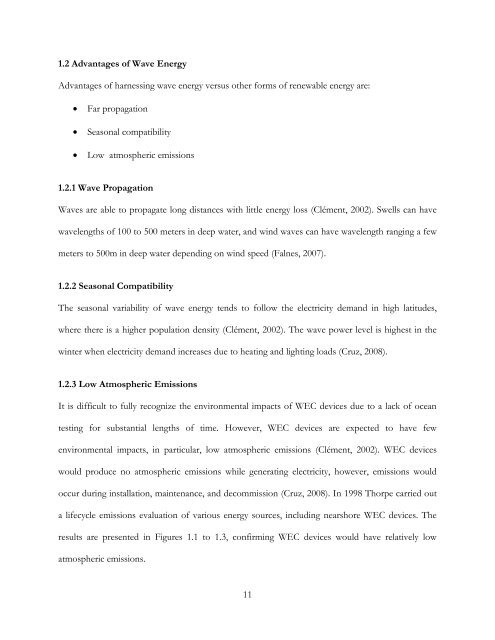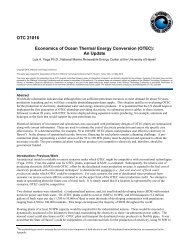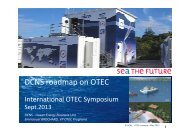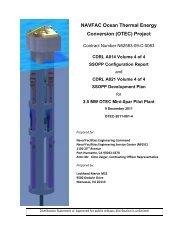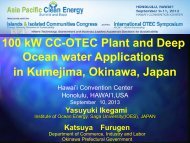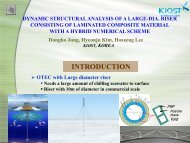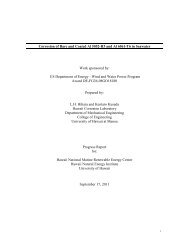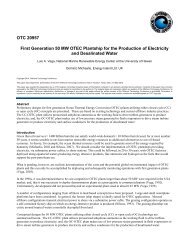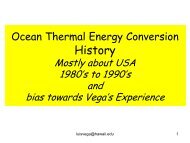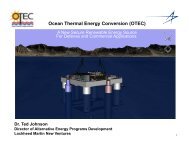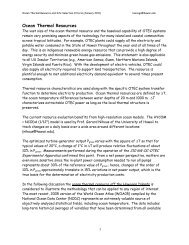CHAPTER 1. INTRODUCTION1.1 Interest in Wave <strong>Energy</strong>The increase of oil prices in response to the Arab-Israeli war of 1973 initially prompted interest inwave energy. A barrel of oil in mid-1973 cost $2.90, by December of the same year the cost hadrisen to $11.65 per barrel (Ross, 1995). This excitement in wave energy was further stimulated bySalter’s Nature article in 1974, introducing Salter’s Duck achieving 90% power absorption efficiency(Falnes, 2007). As oil prices declined in the 1980’s, so did funding for wave energy.Increases in population, standard of living, and dependency on technology indicate a future increasein energy demand (Fujita, 2002). This increase in energy coupled with recent concern for climatechange and rising oil prices has again generated interest in wave energy. Establishment of projectssuch as: the European <strong>Marine</strong> <strong>Energy</strong> Centre, EquiMar, SuperGen, Wave Hub, and <strong>Marine</strong> <strong>Energy</strong>Accelerator indicates a growing support for wave energy research and development in Europe(Drew, 2009).The United States participation in the development of wave energy conversion (WEC) devices hasbeen low thus far. Between 1979 and 1996, the U.S. Department of <strong>Energy</strong> (DOE) only contributedabout $1.5 million dollars to wave-related activity (Brooke, 2003). However, in 2008 the DOEcreated two <strong>National</strong> <strong>Marine</strong> <strong>Energy</strong> Centers in partnership with the University of <strong>Hawaii</strong>, OregonState University, and the University of Washington (McCormick and Ertekin, 2009). The programaims to research power generation form various forms of ocean energy (McCormick and Ertekin,2009). Although private companies, such as Ocean Power Technologies Inc. (OPT) and Aqua<strong>Energy</strong> Group, have been working in the United States on wave energy projects, they have yet toproduce any published results.10
1.2 Advantages of Wave <strong>Energy</strong>Advantages of harnessing wave energy versus other forms of renewable energy are:Far propagationSeasonal compatibilityLow atmospheric emissions1.2.1 Wave PropagationWaves are able to propagate long distances with little energy loss (Clément, 2002). Swells can havewavelengths of 100 to 500 meters in deep water, and wind waves can have wavelength ranging a fewmeters to 500m in deep water depending on wind speed (Falnes, 2007).1.2.2 Seasonal CompatibilityThe seasonal variability of wave energy tends to follow the electricity demand in high latitudes,where there is a higher population density (Clément, 2002). The wave power level is highest in thewinter when electricity demand increases due to heating and lighting loads (Cruz, 2008).1.2.3 Low Atmospheric EmissionsIt is difficult to fully recognize the environmental impacts of WEC devices due to a lack of oceantesting for substantial lengths of time. However, WEC devices are expected to have fewenvironmental impacts, in particular, low atmospheric emissions (Clément, 2002). WEC deviceswould produce no atmospheric emissions while generating electricity, however, emissions wouldoccur during installation, maintenance, and decommission (Cruz, 2008). In 1998 Thorpe carried outa lifecycle emissions evaluation of various energy sources, including nearshore WEC devices. Theresults are presented in Figures 1.1 to 1.3, confirming WEC devices would have relatively lowatmospheric emissions.11
- Page 1 and 2: Geometric Effects on Maximum Power
- Page 3 and 4: ABSTRACTNumerical simulations are c
- Page 5 and 6: 3.7 Absorbed Wave Power ...........
- Page 7 and 8: LIST OF FIGURESFigurePageFigure 1.1
- Page 9: NOMENCLATUREA=incident wave amplitu
- Page 13 and 14: for various projects. Included in t
- Page 15 and 16: pollution would occur from hydrauli
- Page 17 and 18: Figure 1. 7 Average Annual Wave Pow
- Page 19 and 20: Backer (2009) numerically and exper
- Page 21 and 22: CHAPTER 2. WAVE ENERGY CONVERSION D
- Page 23 and 24: 2.3 OrientationOrientation is defin
- Page 25 and 26: Figure 2.4 Oscillating Water Column
- Page 27 and 28: 2.5 Reference PointMeans of reactio
- Page 29 and 30: Linear GeneratorTurbineRotary Gener
- Page 31 and 32: Table 2. 1 WEC ClassificationsDevic
- Page 33 and 34: 33P.T.O.MooringReferencePointOperat
- Page 35 and 36: CHAPTER 3. THEORY AND GOVERNING EQU
- Page 37 and 38: F(x,z,t) z 0DFDtFt u F 0 0 (4
- Page 39 and 40: in ni(13)on S for i=1, 3in( r n)i3
- Page 41 and 42: I iAg e ekz i( kx t)(30)cosh( k(z
- Page 44 and 45: where ijkis the permutation symbol.
- Page 46 and 47: Mw k ieitS( D I) ijkrinjdS(46)3.3.3
- Page 48 and 49: Due to Kirchhoff decomposition, rec
- Page 50 and 51: TE KE PE 20L Asin(kx) 1 2(61)dV d
- Page 52 and 53: P I Iw dS (70)tnSIf the column
- Page 54 and 55: 221 2P gA C(77)max g2 3.8 Maximum
- Page 56 and 57: 4.2 AQWA Modeling ProcedureThe user
- Page 58 and 59: : Local data has changed, and the c
- Page 60 and 61:
Figure 4. 5 Drawing in Design Modul
- Page 62 and 63:
12. Delete all lines inside the cur
- Page 64 and 65:
22. Edit the details of the slice u
- Page 66 and 67:
Figure 4. 15 Details of the Part7.
- Page 68 and 69:
Figure 4. 17 Details of the Mesh4.2
- Page 70 and 71:
Figure 4. 21 Detials of the Wave Di
- Page 72 and 73:
5. Highlight Diffraction + Froude-K
- Page 74 and 75:
Table 4.1 Body Dimensions for Numer
- Page 76 and 77:
concavity from concave down to conc
- Page 78 and 79:
Figure 4. 29 Maximum Power Absorpti
- Page 80 and 81:
Table 4. 3 Numerical ResultsBodyNo.
- Page 82 and 83:
BodyNo.Bodyλ atT=2.1λ atT=1.0λ a
- Page 84 and 85:
WAVEFigure 5. 1 Body Faces Wave Mak
- Page 86 and 87:
The body connects to the aluminum p
- Page 88 and 89:
also allowed for flexibility in cre
- Page 90 and 91:
AB1 23 4 5 6 7CD8 9 10 11EFigure 5.
- Page 92 and 93:
and minimum voltage range of the DA
- Page 94 and 95:
Figure 5. 11 Deleting a Step from L
- Page 96 and 97:
Figure 5. 14 Recording Options, Sig
- Page 98 and 99:
Figure 5. 17 Right-mouse Click on t
- Page 100 and 101:
Zero-OffsetThe Zero-Offset step rem
- Page 102 and 103:
Figure 5. 24 Filter Step Set-up, Co
- Page 104 and 105:
5.6 Data ProcessingFigure 5. 26 Wav
- Page 106 and 107:
5.8 Experimental DiscussionAs menti
- Page 108 and 109:
5.8.3 Suggestions for Future Resear
- Page 110 and 111:
110ikxxRekddzkgkn )cosh())(cosh(,
- Page 112 and 113:
Proof M ij and B ij are Symmetric T
- Page 114 and 115:
BIBILIOGRAPHYANSYS. (n.d.). ANSYS A
- Page 116:
Trust, C. (2011). Capital, Operatin


